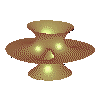
Costa's surface (Celsoe Costa)
From a distance this surface looks like a catenoid with an equatorial plane.
It contains two straight lines which intersect orthogonally. Additionally
it has two planar symmetries. About 200 years after the discovery of the
catenoid and helicoid this was the first none periodic example of a complete
minimal surface without self-intersections (it is embedded).
David Hoffman and Jorge Meeks
were the fist ones who succeeded in showing a computer-graphic of this
surface in the year 1983.



How do I get the complete surface from the symmetries when using
GRAPE?
The input file name of these surfaces is costa.am.
You have to carry out two operations of reflection.
First reflect on one of the planar symmetry lines. Then reflect on one of the
two straight lines.
 Return to the surface list.
Return to the surface list.
 Return to the project list.
Return to the project list.
 Go back to the main menu.
Go back to the main menu.
grape@iam.uni-bonn.de




 Return to the surface list.
Return to the surface list.
 Return to the project list.
Return to the project list.
 Go back to the main menu.
Go back to the main menu.